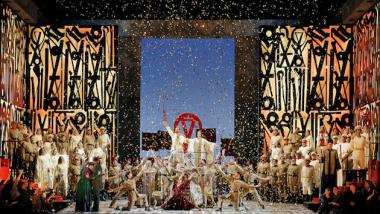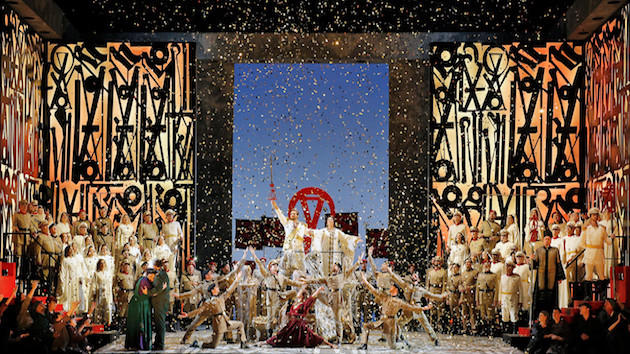
When was the last time you attended a production of Verdi’s Aida where the quiet end of the prelude was followed almost immediately by an explosion? Never? Welcome to the San Francisco Opera’s new production of the opera, which powerfully steers Aida away from its origins in 19th-century orientalism and into the present day. Directed by Francesca Zambello and designed by visual artist RETNA, the production not only avoids the many racial pitfalls in the plot, it vividly, and sometimes shockingly, highlights just how militaristic the opera is.
Related Article
Aida Features RETNA’s S.F. Opera Debut
The production team uses the most direct and economical means to accomplish this. The soloists and chorus appear in their natural skin tones, some standard stage makeup notwithstanding. No palm trees, pyramids, or elephants are in sight. RETNA has created giant abstract icons to decorate the sets and scenery that vaguely suggest hieroglyphics, but also Thai and Sanskrit scripts. The sets, by Michael Yeargan, sometimes resemble concrete bunkers, and while there’s a good deal of fabric used to soften the general look, the production is a far cry from Zandra Rhodes’s campy 2010 extravaganza.
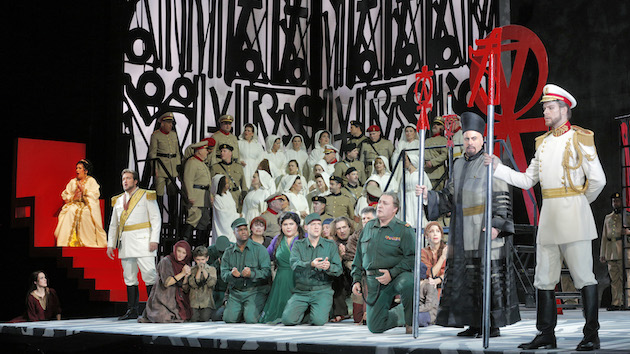
Costume designer Anita Yavich has dressed the men in modern military uniforms rather than in fantasies of Egyptian clothing, with the Egyptian officers’ uniforms most closely resembling naval dress whites. The few Ethiopian soldiers we see are in green, an echo of Aida’s green and purple gown. We can’t forget that we’re seeing a war in progress.
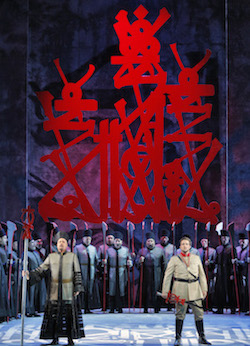
The priests are dressed in abstract black outfits slightly suggestive of Japanese armor. Amneris wears elegant floor-length gowns, some with geometric edging. The only costuming misstep is the cringeworthy, hippie-like flowered garments worn by the female choristers during the Act 2 scene in Amneris’s chambers.
Above all, though, it’s the potent choreography by Jessica Lang (with associate choreographer Clifton Brown) that shocks us. No fake exoticism here; in the first temple scene, the dancers are plainly clad, the dance abstract. In the triumphal scene, she gives us ballet dancers in military uniform, goose-stepping, raising their arms in military salutes, and pursuing, trapping, and abusing a woman in a blood-red dress. The usually irrelevant dance sequences of French grand opera are, finally, put to good thematic use; highest praise to solo dancers Rachel Little and Jekyns Peláez.
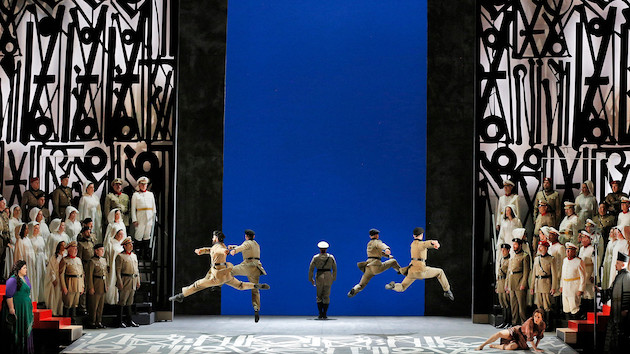
Zambello’s direction is frustratingly inconsistent. The opening scene is usually staged with Radames and Ramfis alone on stage conversing about the upcoming war. Zambello instead makes officers poring over maps more prominent than the two soloists, a brilliant move. The triumphal scene is carefully laid out, but crowd movements in the temple scene and elsewhere seem random and unmotivated. Crucially, her direction of the principal singers is appropriate but rarely particularly insightful, a surprise given the excellence of Zambello’s work in the Ring, especially in Siegfried.
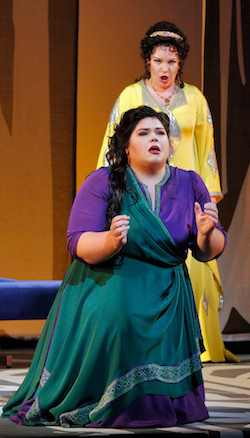
Soprano Leah Crocetto, making her role debut as Aida, turned in a tender, youthful, and beautifully sung performance. Superb and moving in “Ritorna vincitor!” (Return victorious), seductive in the Nile scene’s “Là tra foreste vergini” (There where the virgin forests rise), her sweet lyric soprano made her a vulnerable Aida. She has more than enough vocal power for the big moments, and while it’s still a bit of a work in progress, the role is a fine fit for her.
Brian Jagde, debuting as Radames, remains a frustratingly inconsistent singer, pushing too hard at the top of his range, but incisive and with a good line in the more conversational portions of the score. He sounded best at the low end of his range in the tomb scene at the very end of the opera. Is his transformation from baritone to tenor still in process and somehow incomplete? Jagde also isn’t so magnetic on stage that you can believe that two princesses would be madly in love with him, a real problem in an opera where so much of the plot turns on that competition and the resulting jealousy.
It’s especially true when one of them is Ekaterina Semenchuk’s Amneris, a woman so passionate and attractive that it’s obvious that she could have any man she wants. Semenchuk’s was the most vocally assured and dramatically compelling portrayal of the evening, her darkly brilliant mezzo ringing out clearly in the crowd scenes and in the judgement scene with the priests.
George Gagnidze was a good Amonasro, dramatically convincing, with a warm baritone that falls slightly short of the ideal Verdi baritone in range and power. Raymond Aceto was a forcefully grim presence as the priest Ramfis.
The three Adler Fellows in the cast were all standouts. Anthony Reed sang with considerable presence as the King of Egypt. Tenor Pene Pati was an unusually vivid and powerful Messenger, while Toni Marie Palmertree sang gorgeously as the Priestess.
On opening night, the Opera Chorus performed with its usual enthusiasm and good sound, but with some occasional unruliness. The opera is well-served by Music Director Nicola Luisotti’s conducting. He shaped the long and complex score with a sure hand, fine control of the work’s ebb and flow, and virtually no eccentricity. Special kudos to beautiful solos from Julie McKenzie, flute; Mingjia Liu, oboe; Janet Popesco Archibald, English horn; Jose Gonzalez Granero, clarinet; and Olga Ortenberg-Rakitchenkov, harp.

